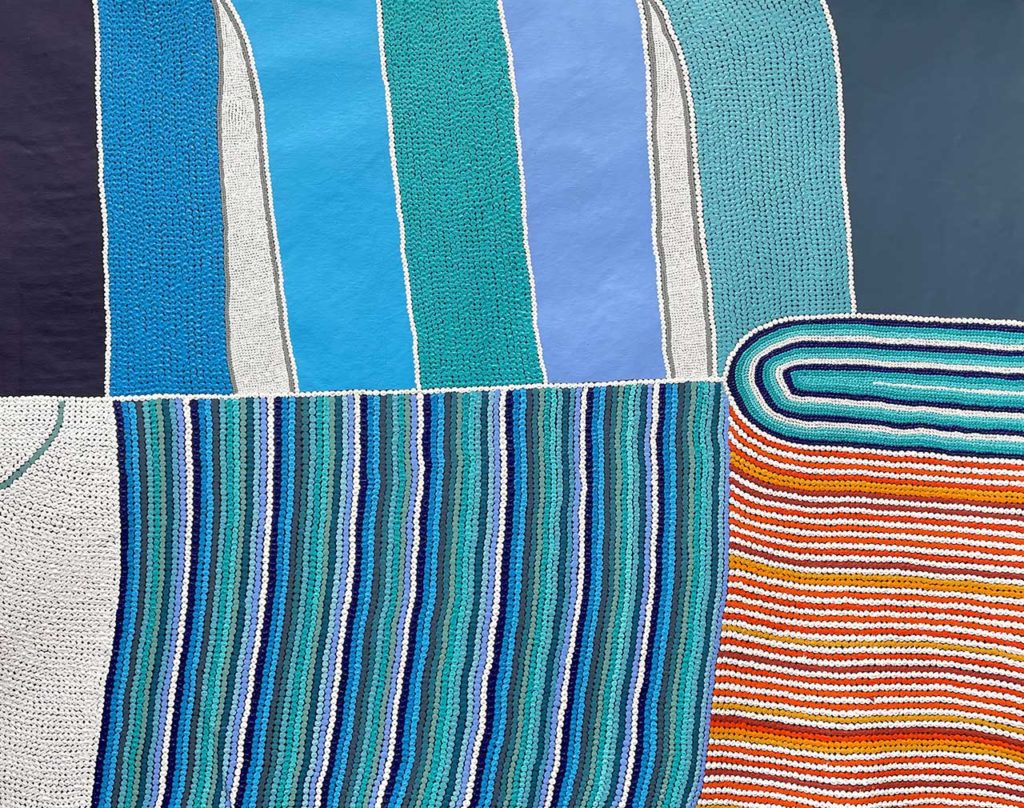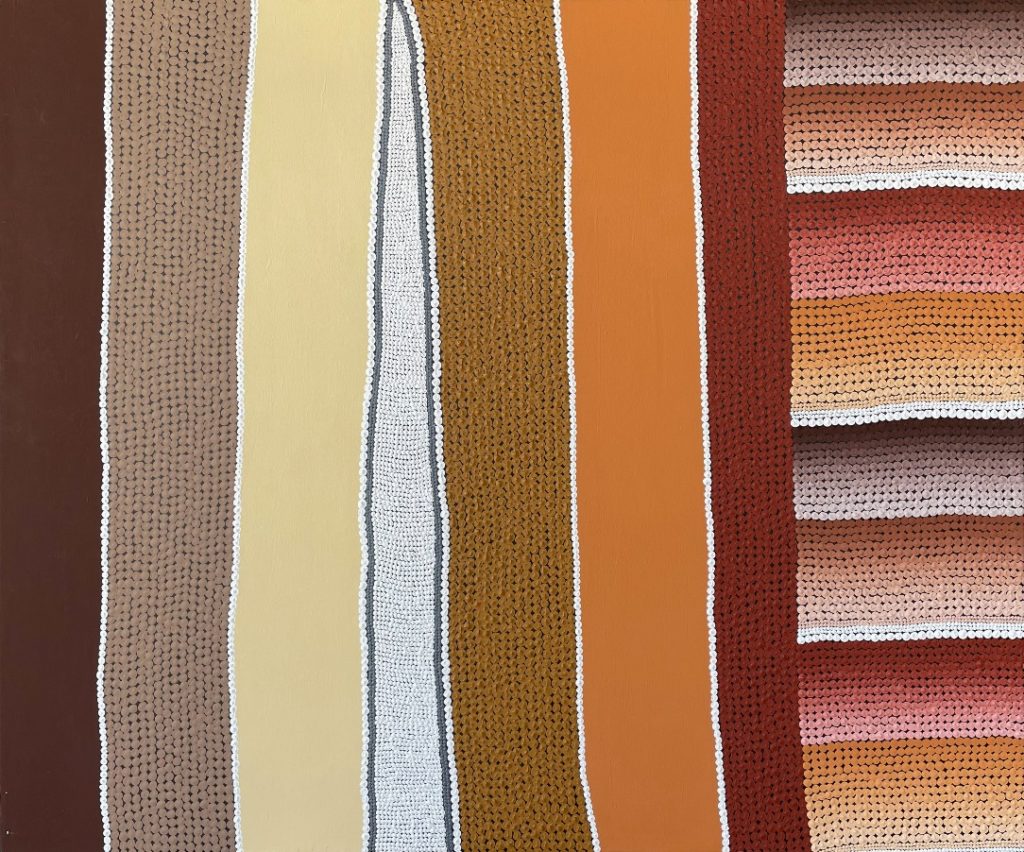Amanda Westley Taking Ngarrindjeri Art To The World
It's a big step for any artist to quit their day job to focus on their artistic career. It's an even bigger step when you're a single mother supporting a young family. This is exactly what Ngarrindjeri artist Amanda Westley did in 2019.
As the world prepared to deal with the uncertainty of a pandemic, Amanda left her job to take on art-making full time. In parallel, she enrolled in study, in a course in Endangered Aboriginal Language with a focus on the Ngarrindjeri language. To her delight, this became a profound piecing together of her own lost family history and cultural identity. In this interview, we check in with Amanda to find out more about how these elements have affected her artistic practice.
It's been three years since we last spoke. How have things been in your art world during that time?
It's been crazy. It's been wild. In 2019, I quit my job and turned my art into a business, and now this is all I do. I had been teaching at a local primary school. I was the Aboriginal Education Officer there, and decided to quit. It was 2019, and the pandemic was taking off.
It was a risk for me, because I have the kids to support. We'd gone through a really traumatic event and I had that decision to make. I needed to choose whether to go back into teaching or be at home with the kids. I decided I'll throw it all in and turn art making into a business and see if we can survive through the pandemic.
It's been good. It's been a ride. We'd left behind our home when we moved back here, we were kind of between homes. It was a really bad, traumatic time, and we just didn't really have a place to live either. I was thinking "What do we do? Do we turn my painting into a business and stay home and just see if we can stay afloat?" It was a gamble and it has worked out well.
Now that you have a focus on your art, what has been the impact on your work?
It has pros and cons. It's been so great to pick my own hours and the days that I work and have that quality time. If my kids are sick, like they have been, I get to be home. I don't have to worry about anything. I can work around the needs of my family. The only downside is there's no steady week-to-week income. I go from exhibition to exhibition, and I have to survive in between. Sometimes I think, "Oh, I don't know how much longer I can survive." Then I have a big exhibition, and I do really well. But it's that unknown element that can make me nervous.
What does it mean for the actual art itself, what you're producing?
Again, that has pros and cons as well. The negative side of that is I don't have the freedom to sit there and play around with ideas because there is pressure to finish work because selling it is my main income. I don't have that extra job that takes that financial pressure off me so I can sit and take the time to play.
The positive side of making it a full-time thing is that it's my every day now, which is just like a dream come true, really. I feel that I need to paint all the time. I can do that every day. My art has become my sole focus. I don't have to worry about a second job and other responsibilities in another job. I'm now so focused on my art because of that shift. I've got that time to really work on myself and develop as an artist.



How would you describe how your work has grown in those three years?
My level of confidence has changed so much. I'm super confident in what I'm producing now. I think that shows in my work. My knowledge of language has grown along with my art.
I did my study in Endangered Aboriginal Language. The course ran over a couple of years and it was run with my elders. I just fell in love with learning the language. There are very few fluent speakers left. I feel like it was really important for me to learn as much as I can, and incorporate that into my art. I just love it. Then I started teaching a little here and there in a way where I could use my art and language. I think you see a lot more cultural references in my art as well.
I started including language when I was engaging with people on social media and that really encouraged me. People were responsive, not just to my art, they wanted to know more about the language. People were intrigued by it. It's great to be able to interact with people more on social media with language.
What impact did Covid have on you and your work?
When I quit my job and started to focus on art full time, I was worried, because that was right at the start of the pandemic and everyone was really unsure of what to do. I was anxious. I was like, "oh my gosh, no one's going to spend money in a pandemic", but it was the complete opposite for me. I think that was probably one of my most successful years, 2019-2020. Maybe it was because no one could travel and everyone had money to spend on art. I found everyone was renovating houses and that sort of thing. I was super busy with art. For me, it turned out to be a really successful time to start a business.
I feel very blessed to say that because I know that's not a story for everyone. I know a lot of people lost businesses and all kinds of work opportunities disappeared. It just turned out to be a good start for me. Then I rode that wave for a little while, and then it quietened down a bit lately as the cost of everything went up. Still, I would say 99% of my sales are through social media.
Every time that I've been asked to do an exhibition, I've been contacted through social media rather than email or telephone. I do a quick little post on Instagram with a photo and maybe a title. And I kind of left it at that. It was still quite active. Then I started writing more about language and the response for those posts just blew up. Instead of two or 300 people liking my post, there were over a thousand people liking my post when it was in language. The personal messages were, "We love the story behind it, we love the language. Can you start doing more of it on your post?" This was such a strong positive response. I considered how I could find the time to sit down and write more about it.
Coming back to your question, I'm trying to think how my art has changed with language. I think the focus is still there in Ngarrindjeri country. Maybe the connections are just a little bit deeper, I think. I'm still painting the same things. I just think I'm adding more detail to it, maybe, the more I know. It's coming through in the art.
How did the elders respond to your art?
When I first started, I was always quite scared. Now I'm more confident to show the person behind my art. I always wanted it just to be the art and not so much me, because I was worried about people's response to my art. I wasn't confident about it, but I think so much has changed.
There were five Ngarrindjeri artists that got picked to do the artwork for the new causeway that was being built to Granite Island down here. This artwork would be the biggest Aboriginal art piece, I think ever. It would be there for over a hundred years. I got asked to do it and my elders were the ones that chose us to do it. I was one of the five and just felt like it really solidified my role within my community as a modern, Ngarrindjeri artist.
I worked with four other family members on that project. It was huge. I got to meet with elders who I had never met before and that was just so amazing. It gave me a huge confidence boost, that I am really recognised as a Ngarrindjeri artist by my own community.
So that brings me to, how do you think Ngarrindjeri culture is going generally? What do you see? What changes are you seeing?
The changes are slow, but there's so much talk about positive things, because it's such a rich culture down here. I feel like not many people realise that when they come here. I think it's just starting to become quite a big conversation now, which is quite positive. But yeah, it's a slow process. So we have so many ideas of getting a permanent Ngarrindjeri art space where people can learn about the culture that's down here. Probably all places could say that about the culture in their town. There's talk of it, but it is quite slow.
What ideas have you been developing for your art going forward? Where do you see it going?
Having my work exhibited overseas would be huge. My art representing Ngarrindjeri culture overseas would be massive. For not just me, but the rest of my mob, it would be huge. Not only that, it is also about raising the profile of our local artists. I only had this chat the other day with another Ngarrindjeri artist. We feel like a lot of our mob up north are more recognised than we are down here. I would love my work to get Ngarrindjeri art just a little bit bigger and a little bit more recognised in Australia, I think would be awesome. What I see it doing is paving an easier way for younger generations.
So the three things that you'd like to see is your culture celebrated through your art being seen overseas, raising the profile of your community and its visual culture within Australia, and also letting your art pave the way for younger artists from your community to be stepping up.
Yes. Making it just a little bit easier for them. I feel like it's still quite new, and I'm still trying to figure it all out. But yeah, I love it. I don't have any regrets.
Top Featured Image: Amanda Westley | Mi:Mini - Women | Jap 019752
View:
Amanda Westley – Colours of Ngarrindjeri Country (2022)
Amanda Westley & Kudditji Kngwarreye Spirit of Place (2019)
Read:
Amanda Westley at Home on the Coorong (2019)
Amanda Westley & Kudditji Kngwarreye Spirit of Place (2019)
The Painting of Me - Interview with Amanda Westley (2018)
Amanda Westley (Conway-Jones) First Solo Show at Japingka

